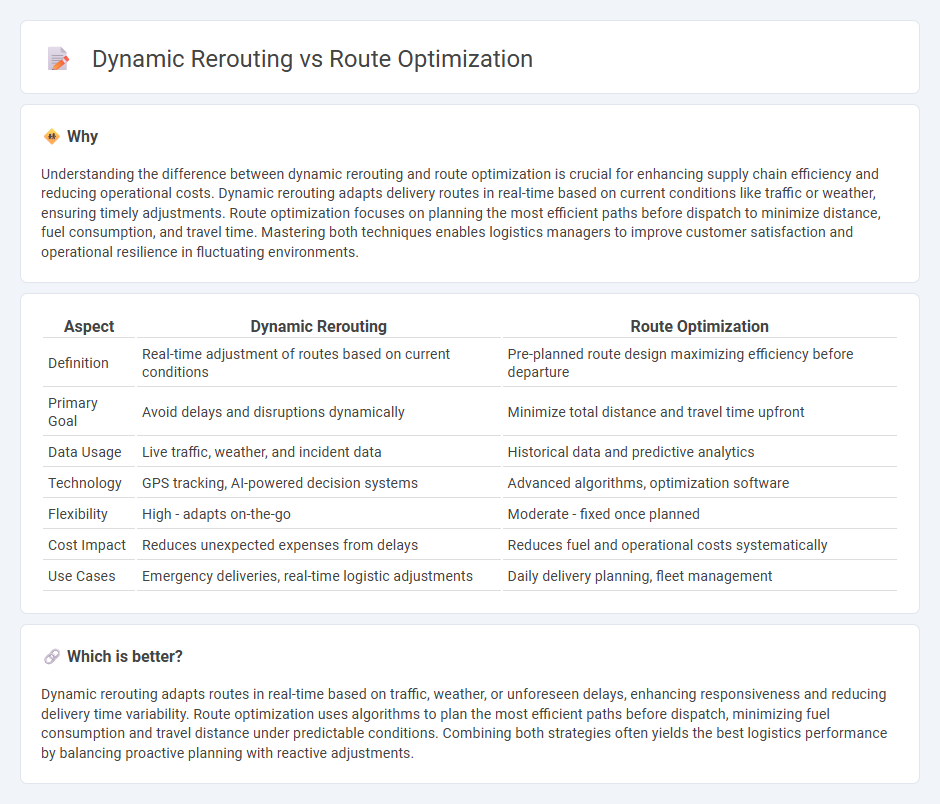
Dynamic rerouting adjusts delivery paths in real-time based on traffic conditions, weather, or unexpected delays, enhancing responsiveness and reducing transit times. Route optimization focuses on planning the most efficient routes before dispatch, minimizing costs and fuel consumption through advanced algorithms. Explore the benefits and applications of both strategies to improve logistics efficiency.
Why it is important
Understanding the difference between dynamic rerouting and route optimization is crucial for enhancing supply chain efficiency and reducing operational costs. Dynamic rerouting adapts delivery routes in real-time based on current conditions like traffic or weather, ensuring timely adjustments. Route optimization focuses on planning the most efficient paths before dispatch to minimize distance, fuel consumption, and travel time. Mastering both techniques enables logistics managers to improve customer satisfaction and operational resilience in fluctuating environments.
Comparison Table
| Aspect | Dynamic Rerouting | Route Optimization |
|---|---|---|
| Definition | Real-time adjustment of routes based on current conditions | Pre-planned route design maximizing efficiency before departure |
| Primary Goal | Avoid delays and disruptions dynamically | Minimize total distance and travel time upfront |
| Data Usage | Live traffic, weather, and incident data | Historical data and predictive analytics |
| Technology | GPS tracking, AI-powered decision systems | Advanced algorithms, optimization software |
| Flexibility | High - adapts on-the-go | Moderate - fixed once planned |
| Cost Impact | Reduces unexpected expenses from delays | Reduces fuel and operational costs systematically |
| Use Cases | Emergency deliveries, real-time logistic adjustments | Daily delivery planning, fleet management |
Which is better?
Dynamic rerouting adapts routes in real-time based on traffic, weather, or unforeseen delays, enhancing responsiveness and reducing delivery time variability. Route optimization uses algorithms to plan the most efficient paths before dispatch, minimizing fuel consumption and travel distance under predictable conditions. Combining both strategies often yields the best logistics performance by balancing proactive planning with reactive adjustments.
Connection
Dynamic rerouting leverages real-time data to adjust delivery paths instantly, reducing delays and improving efficiency. Route optimization algorithms analyze variables such as traffic conditions, delivery time windows, and vehicle capacity to determine the most cost-effective and timely routes. Together, these technologies enhance supply chain resilience by enabling adaptive, optimized transportation decisions.
Key Terms
**Route Optimization:**
Route optimization enhances logistics efficiency by calculating the most cost-effective and time-saving pathways based on variables like traffic, distance, and delivery windows. It incorporates advanced algorithms and real-time data to plan routes that minimize fuel consumption and maximize on-time deliveries. Discover how route optimization can transform your transportation management system for greater productivity.
Shortest Path Algorithm
Shortest Path Algorithm is fundamental in route optimization, aiming to find the most efficient path between two points by minimizing distance or travel time, thereby enhancing logistics and transportation efficiency. Dynamic rerouting leverages real-time data to adjust routes spontaneously in response to traffic conditions, accidents, or road closures, improving adaptability and reducing delays. Explore the intricacies of Shortest Path Algorithm and its role in dynamic rerouting to optimize your navigation strategies.
Cost Minimization
Route optimization leverages algorithms to identify the most cost-efficient paths by minimizing fuel consumption, travel time, and vehicle operating costs. Dynamic rerouting adjusts routes in real-time based on traffic conditions, accidents, and road closures, aiming to reduce delays and avoid unexpected expenses. Explore detailed strategies and tools for cost minimization in route planning to enhance operational efficiency.
Source and External Links
Route Optimization Basics - This webpage provides insight into the process of improving routes for better efficiency and cost-effectiveness, focusing on strategic planning and real-time adjustments.
Ultimate Guide to Route Optimization - This guide outlines the basic steps to get started with route optimization, including importing addresses and setting route constraints to achieve the most efficient routes.
What is Route Optimization - This resource explains how route optimization helps companies reduce operating costs, improve customer service, and optimize fleet asset utilization by evaluating multiple delivery permutations.
 dowidth.com
dowidth.com